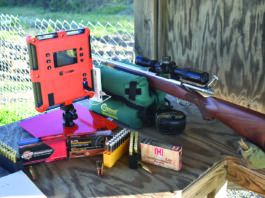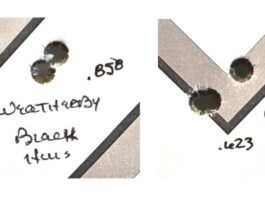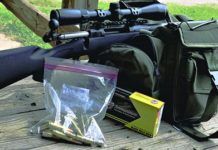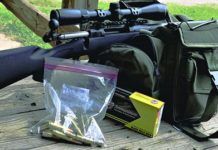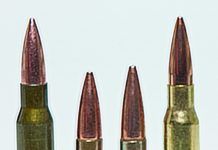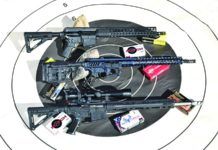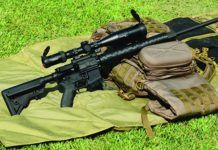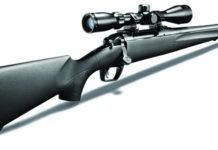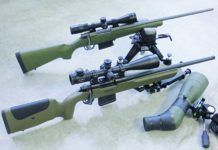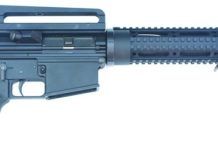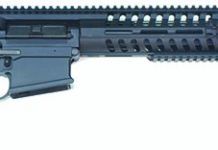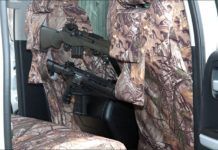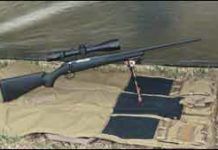Which 308 Bolt-Action Rifles Would We Take to the Woods?
The 308 Winchester is one of our more popular and most versatile cartridges. Accurate, powerful enough for most anything in North America save the largest bears, and affordable, the 308 Win. has a lot going for it. Among the most popular firearms chamberings for this cartridge is the bolt-action rifle, and we recently tested four examples to see which one might make a timely Christmas present for yourself or someone else who would like something long and skinny under the tree.
In some ways, this report was a continuation of the test we ran in the October 2017 issue, which used the Savage Axis, Remington SLP, Remington Varmint rifle, and Browning BAR, all in 308 Winchester. This time, we included a rifle that would be a match for the Remington Varmint rifle previously tested — the Savage Model 12 with bull barrel was the heaviest rifle this round. In the previous feature, the editor noted that none of the rifles seemed to excite the testers. He was correct. This time around was different. This time we got excited and found the rifles are interesting and appropriate to the job at hand.
We really liked one rifle and felt that it was a Best Buy and a great all-round choice. Also, a more-recent version of an existing model was well worth its modest price. Because we are always looking for a low-cost gem, we added a bargain-basement used gun whose specific model we hadn't previously tested in the magazine. The Mossberg Trophy Hunter rifle line (there is also a Savage Trophy Hunter, so don't be confused) has been replaced by the Mossberg Patriot series.
The Savage Model 12FV was the most accurate rifle in the test and received high marks for its smooth action and three-position safety. The only question was, would you be willing to lug this rifle around the woods or bring it to the stand?
Which 308 Bolt-Action Rifles Would We Take to the Woods?
The 308 Winchester is one of our more popular and most versatile cartridges. Accurate, powerful enough for most anything in North America save the largest bears, and affordable, the 308 Win. has a lot going for it. Among the most popular firearms chamberings for this cartridge is the bolt-action rifle, and we recently tested four examples to see which one might make a timely Christmas present for yourself or someone else who would like something long and skinny under the tree.
In some ways, this report was a continuation of the test we ran in the October 2017 issue, which used the Savage Axis, Remington SLP, Remington Varmint rifle, and Browning BAR, all in 308 Winchester. This time, we included a rifle that would be a match for the Remington Varmint rifle previously tested — the Savage Model 12 with bull barrel was the heaviest rifle this round. In the previous feature, the editor noted that none of the rifles seemed to excite the testers. He was correct. This time around was different. This time we got excited and found the rifles are interesting and appropriate to the job at hand.
We really liked one rifle and felt that it was a Best Buy and a great all-round choice. Also, a more-recent version of an existing model was well worth its modest price. Because we are always looking for a low-cost gem, we added a bargain-basement used gun whose specific model we hadn't previously tested in the magazine. The Mossberg Trophy Hunter rifle line (there is also a Savage Trophy Hunter, so don't be confused) has been replaced by the Mossberg Patriot series.
The Savage Model 12FV was the most accurate rifle in the test and received high marks for its smooth action and three-position safety. The only question was, would you be willing to lug this rifle around the woods or bring it to the stand?
Threaded-Barrel Bolt Guns In 300 Blackout and 308 Win.
A few years ago, the incidence of factory-supplied threaded barrels on rifles was negligible, because most people didn't have a lot of interest in changing their muzzle devices, including flash suppressors and sound suppressors. Sound suppressors, also incorrectly known as silencers, and more accurately called "mufflers" or "moderators," just weren't that common because the devices were regulated by the National Firearms Act (NFA) of 1934. In that law, Congress used its tax power to set up a tax-and-registration system for machine guns, short-barreled shotguns and rifles, grenades, mortars and various other devices, including sound suppressors.
Under the NFA today, a prospective owner must go through a months-long registration process with the Bureau of Alcohol, Tobacco, Firearms and Explosives (BATFE) and pay a $200 tax, in advance, before he or she can purchase a suppressor. Despite the difficulties posed by the regulatory system, suppressor sales have continued to grow over the last decade, and especially the last five years. Suppressor ownership is legal in most states. The exceptions are Hawaii, California, Illinois, New York, New Jersey, Delaware, Rhode Island, and Massachusetts. In the 42 states where suppressors are legal, they are allowed for hunting in all but Connecticut and Vermont, and states are de-regulating suppressor use every day, so this list may be outdated by the time you read this.
Concurrent with the sales growth of suppressors, manufacturers have responded by making the muzzles of some of their rifles and pistols easier to receive the devices. Thus, the growth of factory-threaded barrels, three models of which we recently tested, with and without a suppressor.
AR-10s in 308 Win. and 6.5CM: $995 E.R. Shaw Is a Best Buy
Many people would agree that the AR platform is the most versatile of all rifle designs. Created for military combat (as many sporting rifles were originally), Eugene Stoner's design can be long, short, scoped, topped with iron sights, and maintained by novice operators with just a short list of tools. Also, the design allows for a choice of cartridges, for it is the chambering that defines what it can effectively be used for. In this test, we pitted a gas-impingement-operated 308 Winchester AR-10 against a piston-operated 308 and a gas-impingement AR-10 chambered for what is becoming a popular standard cartridge, the 6.5 Creedmoor.
Our 308 Winchester AR-10s were the $3955 BDR10-3G Black/Blue Splash direct-impingement system and SIG Sauer's $3108 716G2 DMR piston-driven system. A new rifle from the makers of E.R. Shaw Barrels, the E.R. Shaw ERS-10 chambered for 6.5 Creedmoor ammunition was a direct-impingement firearm carrying a list price of $995.
We chose four different rounds for collecting accuracy data from the 100-yard line at American Shooting Centers in Houston. The 308 rifles were fed SIG Sauer's 150-grain HT and 168-grain Open-Tip Match (OTM) ammunition, and two rounds from Black Hills Ammunition. They were the 155-grain Sierra Tipped MatchKing (TMK) rounds and the 175-grain boat-tailed hollowpoints (BTHP). Our 6.5 Creedmoor selections for the E.R. Shaw rifle were Federal's 140-grain soft-point "Non-Typical" White Tail rounds and three varieties from Hornady. They were the 140-grain Extremely Low Drag (ELD) Match, 143-grain ELD-X Precision Hunter, and the 147-grain ELD Match rounds. For optics we relied upon our Steiner 4-16x50mm Steiner Predator Xtreme first focal plane scope mounted inside a pair of 30mm Warne rings atop a riser from Yankee Hill Machine. Let's find out which of our rifle trio was most accurate, reliable, and versatile.
Bigger ARs: 6.5 Creedmoor, 6.5 Grendel, & 308 Winchester
The history of popular firearms in the 21st Century (so far) has been indelibly marked by the rise of civilian-owned AR-15 semi-automatic rifles. What most people don't know is that the system was originally intended to fire larger-caliber ammunition than 5.56mm or 223 Remington. Designed by Eugene Stoner, the AR-10 (the "AR" is short for "ArmaLite Rifle," not "assault rifle" as many non-gunners believe) evolved from the 7.62x51mm NATO chambering to smaller calibers for greater reliability and practicality; in particular, soldiers were able to carry more ammunition because the bullets and magazines were smaller and weighed less. The structure of the rifle itself could be made lighter as well without the fear of receivers cracking or pins working loose. In this last regard, such was the state of metallurgy and machining in the 1960s.
In today's manufacturing world, advanced technology provides for more exacting tolerances so that finished products are more consistent. And thanks to the space program and other factors, stainless steel and other metals are more malleable and durable than ever. With the Pentagon still chasing a more effective round than 5.56/223 and the public's thirst for a bigger bang, a return to larger calibers for the AR platform was inevitable. In this test we compare three different ways to project larger-diameter bullets. Our first test rifle (or carbine, if you will) was the $3999 MR762A1 from Heckler & Koch. As its nomenclature suggests, the MR762 fires 7.62x51mm ammunition or its American incarnation, 308 Winchester. From Core15 rifles in Ocala, Florida, we chose the $2470 Core30 Tac II chambered in 6.5 Creedmoor, which fired 0.264-inch-diameter bullets. Our third rifle also shot 0.264-inch bullets, but from a cartridge case short enough to be housed in the smaller AR-15 chassis. Alexander Arms managed to stuff Bill Alexander's invention, the 6.5 Grendel, into an AR-15 receiver and topped it off with a 24-inch-long barrel. List price of the Alexander Arms Overwatch rifle we tested was $1613.
For 6.5 Grendel shots of record, we chose 120-grain American Eagle, 123-grain Hornady A-Max, and Alexander Arms' own brand of ammunition topped with the 123-grain Lapua Scenar bullet. Our H&K MR762A1 was treated to 110-grain FB-tipped rounds from Noveske, 168-grain OTM rounds, and 150-grain HT rounds from SIG Sauer, plus a diet of Black Hills Gold 155-grain Tipped Match King ammunition. The Core30 rifle was loaded with all Hornady brand ammunition; the 129-grain White Tail Interlock, 140-grain ELD Match, 143-grain Precision Hunter ELD-X, and 147-grain ELD-Match rounds.
For optics we used both a 4-16x50mm Steiner Predator Xtreme scope and SIG Sauer's new Tango6 4-24x50mm scope. The Tango6 is a compact scope for its maximum power of 24x magnification. In our view, this makes it a good choice for semi-automatic rifles that already have a lot of mass top to bottom thanks to the pistol grip, and you don't want the rings or mount to put weight on the handguard. Both the Steiner and the SIG were first-focal-plane scopes so we could manipulate the size of the reticle. We especially liked using the small dot in the center of the Tango6 reticle. Not really visible until reaching 8x magnification, we were able to enlarge the dot to just the right diameter to indicate dead center but not significantly block the target.
Tests were performed at American Shooting Centers in Houston, Texas. Accuracy data was collected from the 100-yard benches. We also made use of the 400-yard range where a variety of steel targets stood to challenge those who dare. We fired at the 18-inch-wide by 30-inch-tall IPSC/USPSA target to test our skills. With three rifles that were different in concept and caliber, we wondered if one would stand above the others in all aspects of performance. Or would each rifle claim supremacy when viewed in a specific role. Let's find out.
All-Round 308 Winchester Rifle Shoot-Out: Not Our Faves
Looking for a go-anywhere do-anything 308 Winchester-chambered rifle? If so, in this article we test Remington SPS bolt guns in two variants, a Tactical version with a carbine-length barrel at 16.5 inches and the 26-inch barrel SPS Varmint, to get a good look at opposite ends of the length spectrum. Then we added two rifles with more traditional barrel lengths, the 22-inch-barrel Savage Axis and a semi-auto, the Browning Automatic Rifle Stalker, also with a 22-inch tube.
The truth is, these rifles will fire most of their cartridges on a range. This means we'd like them to be comfortable to shoot and deliver satisfying accuracy. Hunting is a consideration, of course, so the rifle should be useful for thin-skinned game to 200 yards or more. The adage of "200-pound game at 200 yards" will apply here. In a dangerous world in which it may be the only self-defense option for some homes, the rifle should also have some utility as an emergency rifle or for area defense. It should handle quickly enough for boar hunting, or varmints and pests, such as coyotes if need be. Area defense simply means that those of us with a larger homestead or a potential campsite do not wish to be helpless if we encounter adversaries. And we'd prefer our choice not cost as much as a Scout.
Obviously, then, we want a dependable, easy-to-shoot, easy-to-carry rifle that's well made. Doesn't sound that hard because we are not expecting to be able to light a match with each round, but we do want to hit the K zone at 200 yards. Some shooters have claimed that shorter, stiffer barrels like that on the Tactical shoot as well as a longer barrel, like that on the Varmint. We are going to see how velocity varies as well, and to compare the chronograph stats bolt guns develop in terms of velocity to that of a semi-auto. We do not want a 4-foot-long 12-pound rifle, but we wondered if we would have to compromise on weight (that is, go heavier) if we do not get the accuracy we want. We are not holding out for accuracy for 50 continuous shots and do not need a heavy target barrel, but, instead, we're looking for a rifle capable of delivering good accuracy for a dozen shots or so. Durability and quality are important. The rifle should last for the shooter's entire life. Also, to save money, we looked for used rifles in Like New or better shape, a standard which all four members of the quartet met.
We elected to fire the rifles in four drills. We would fire quickly at human-silhouette targets at 25 yards, for the SHTF situation. It is also a drill that has some merit in learning to snap-shoot predators and coyote. At 50 yards, we used the Innovative Targets (Innovative Targets.net) steel gong. While we fired for precision, we also wished to test speed to an extent in this drill and fired a combination of standing and kneeling. We would expend 20 rounds in each pursuit, at 25 and 50 yards, for 40 rounds. We also fired 10 rounds at 100 yards offhand. Finally, we fired three three-shot groups for accuracy at 100 yards with three different loads, alternating between rifles to let the barrels cool, firing from a solid rest and attempting to obtain the best accuracy possible. During the offhand firing stages, we used Fiocchi 150-grain FMJs for the 25- and 50-yard work. For firing offhand at 100 yards, we used a handload consisting of the Hornady 155-grain SST and Varget powder for 2750 fps. For benchrest accuracy testing, we used three loads. The Hornady 168-grain ELD Match, Federal 165-grain Trophy Bonded, and Gorilla Ammunition's 175-grain Sierra MatchKing load. Here's how they performed.
All the cartridges tested gave good-enough results as far as baseline expectations, we thought. That is, we had no failures to feed, fire, or eject in the test. And all three produced a level of accuracy we want to see—1 minute of angle, or 1-inch groups at 100 yards—in at least one rifle. For example, the Gorilla Ammunition 175-grain rounds gave the best results in the Remington SPS Varmint at an eye-popping 0.9-inch average group size, then the SPS Tactical at 1.2 inches, the BAR Stalker semi-auto at 1.6 inches, and the Savage at 1.9 inches on average, far behind the leader. We saw the same pattern with the Hornady ELD Match 168-grain Polymer Tip load, with the Varmint again shooting under MOA with a 0.9-inch average group, the Tactical at 1.4 inches, the MK3 BAR at 1.5 inches, and the Axis coming in at 2.3 inches. Likewise, the SPS Varmint lead the parade with the Federal Trophy Bonded 165-grain Polymer Tip load, shooting 1.0-inch average groups. The BAR jumped into second place with this load, shooting slightly better at 1.7 inches than the Tactical's 1.9-inch average. The Axis was fourth again with an average group size of 2.2 inches.
308 Winchester Bolt-Actions: Remingtons M783 Rifle Wins
Among the most useful, versatile, and powerful all-round sporting rifles is the 308 Winchester bolt action. These rifles are accurate, reliable, and can take on small to big game in many hunting conditions. When married with a good optic and in competent hands, they are well suited to take a 200-pound target at 200 yards and beyond, as a rule of thumb. The chambering is a joy to use and fire, compared to hard-kicking magnums, and offers plenty of recreational value. The bolt-action 308 is also a useful tactical rifle in many situations, and the round is widely used by law enforcement across the country.
We recently took a hard look at four bolt-action rifles chambered in 308 Winchester, with a special emphasis on looking for affordable options. So we chose two used rifles and one lower-cost new rifle and compared them to a rifle in a higher price range to ensure we weren't missing something that more dollars could provide. These rifles included the now-discontinued Mossberg ATR, the Remington 783, the Remington 700 SPS, and the Savage Axis. In this quartet, we shot three loads for accuracy testing and another load in offhand fire to gauge the accuracy of the rifles. As it turns out, the economy combination rifle that comes from the factory with a bore-sighted scope is a good deal. Though the Remington 783 was the most accurate rifle, we also liked the Remington 700 SPS a lot. Overall, however, the Savage Axis combination seems a best buy. Let's look hard at these rifles and delve into why we made these choices and to see if you agree with our assessments.
New 308 Win. Bolt Guns: Howa, Mossberg Square Off
One can be spoiled by shooting accurate rifles, and accuracy typically comes at a cost. With the idea of finding a relatively inexpensive rifle that shoots accurately, is consistent, and is easy and comfortable to use, we looked into new rifles from Mossberg, the MVP LR, $945; and from Howa, the Alpine Mountain Package $1577. These two new rifles are both chambered in 308 Win./7.62x51mm NATO and are positioned by their manufacturers to do very different tasks. Even so, the shooter who prizes hole-in-hole performance will be challenged picking between these two because of the inherent trade-offs they present.
The Howa was designed to be a lightweight hunter, and the Mossberg's intent is to shoot accurately at long range. We feel both rifles accomplish their intended purpose, but as you will see, we found a potential pitfall in the Howa's magazine release, and with the Mossberg, we found we wanted better accuracy and a little better set-up for long range. With that said, both of these rifles had sub-MOA accuracy. We were surprised at the accuracy of the Howa and actually expected better accuracy out of the MVP LR, but at the end of testing we were satisfied, but not elated, with the results we achieved with both rifles.
We test-fired both rifles using a sandbag rest, mechanical rifle rest, and bipod in the prone and off a bench at target sets at 100 yards. The firing sequence consisted of five shots. Then we allowed the barrel to cool and changed ammo brand and fired another 5-shot string. Ammunition consisted of a range of bullet weights: Aguila 150-grain FMJ-BT, Hornady Match 178-grain BTHP, and Black Hills 168-grain BTHP. We also increased consecutive shot strings to 10 rounds to see the effect of a hot barrel on accuracy.
The variables in the test were the scopes. The Howa came with a Vortex Viper 3-9x40mm scope. The Viper scope is a traditional hunting scope with screw-on turret caps. With the caps removed, the turrets are pulled up to adjust windage and elevation. The magnification ring is large and easily rotated without disrupting aim. A Dead-Hold BDC reticle is in the second focal plane, so the reticle stays the same size even when magnification is increased or decreased. Subtensions on the reticle can be used to judge holdover for elevation and wind adjustments, but the scope needs to be on the highest magnification setting. We saw a bit of parallax at distances past 100 yards, but for hunting purposes, we could easily live with it. This is a basic scope, and we thought it was a good pairing with the Howa. Initially, we also thought this scope might be a liability compared to the scope we used on the Mossberg, but the little Howa kept pace with the Mossberg from the bench, so the optic wasn't a liability at all.
On the Mossberg LR, we mounted a Meopta ZD 6-24x56mm RD ($2070; MeoptaSportsOptics.com), which is specifically designed for long-range shooting. The Meopta features an illuminated MilDot II reticle with an integrated range finder and is calibrated for tactical calibers like 7.62x51mm NATO/308 Win., 338 Lapua Mag. and 50 BMG/12.7x99mm NATO. The MilDot II RD reticle is located in the second focal plane, and when the magnification is set at 12x, the reticle subtensions can be used for windage and elevation adjustments and range finding. The scope has finger-adjustable windage and elevation turrets; one click for every quarter-minute. Clicks are tactile and audible. We used Weaver Tactical rings and the Picatinny style rail that came with the Mossberg. After bore sighting, the Meopta was easy to zero. We found adjusting the reticle for parallax to be simple, and it showed a clear sight picture all the way to the edges of glass. We really liked this scope, though some would have wanted the reticle in the first focal plane, but all agreed it was well suited for long range work. Here are the details on how these 308 bolt guns shot with these optics.
DPMS LR-308 AP4 7.62x51mm NATO/308 Win., $1399
For the money, there's a lot here. Our gun came with an optional quad rail which adds a little to the price. We think this would make a great hog gun — maneuverable enough to get in and out of pickups or Jeeps, with lots of punch.
The DPMS LR-308-AP4 16-inch carbine was equipped with an upgraded Panther flash hider, whose tips were distinct and sharp for puncturing glass and other light barriers. The barrel had the distinct M4 barrel contour, topped with an older A1-style front sight post/gas valve, which is pinned to the barrel. It appeared to be correctly installed and was secure. The DPMS came with a factory-installed free-float quad rail, which was also well attached, and our team noted that everything was tight and lined up correctly with the upper receiver. Atop the M1913 rail sat a detachable A3-style carry handle with A2-style rear sight. This item appeared well made and held out the promise of good shooting accuracy. We found the A3 carry handle/A2 rear sight assembly clamped directly to the upper receiver's flat-top M1913 Picatinny rail. Removal was easy, requiring two knobs be loosened. The assembly lifted right off the rail.
The buttstock again was familiar; DPMS uses a standard AR-15 6-position carbine stock. It functioned properly and had a considerable rage of adjustment. However, if this were our gun, the team agreed that upgrading the stock would be a vast improvement over the original.
The DPMS test gun came equipped with an upgraded Ergo pistol grip and an upgraded ambidextrous selector switch. In our view, the grip was a definite improvement over the stock A2 pistol grip, in part because the Ergo grip also came with a compartment, which had its own cover/plug. The upgraded ambidextrous selector switch uses a hex-style screw to attach the secondary switch. On arrival, this was loose and had to be tightened. This option produced mixed opinions among the testers. The AR shooter was opposed to redundant controls, while the other two testers liked all the bells and whistles.
Patriot Ordnance Factory P308-20 Gen3 7.62x51mm NATO/308 WIN., $2599
The POF USA Gen3 P308-20 was 42 inches long with a 20-inch fluted barrel tipped with a custom triple-port muzzle brake. On top was a sleek monolithic rail stretching 14 inches in length. A MagPul PRS adjustable buttstock met the shooter's shoulder. The team agreed the rifle felt strong and hefty, and they were pleased with the overall feel. It was well balanced, the metal finishes and coatings were uniform and looked very nice. The mill work on the billet upper and lower receiver was well done.
The receivers fit tightly together and didn't rattle. However, there was an obvious gap at the rear mating of the receivers. The rear and front takedown pins fit and functioned properly with no grinding needed. The upper receiver was equipped with forward assist. The charging handle and bolt-carrier group slid out of the receiver smoothly. The charging handle was machined billet and anodized.
The bolt carrier group was impressive, a custom design by POF-USA that requires little to no lubrication because of a nickel-Teflon plating. It was integrally keyed and uses a custom-designed roller-cam pin that was also NP3 coated. The bolt was chrome plated and heat-treated to mil-spec standards. Disassembly and lubrication were simple to perform, and POF-USA recommends additional lubrication of these parts during break-in.
308s: Rugers SR-762 Versus Springfield Armorys Socom 16
If you haven't noticed, what used to be called the AR-10 platform has made a comeback. Eugene Stoner's design in 308 Winchester (7.62x51mm NATO) has gone on to unprecedented popularity with military and civilian consumers. But many shooters prefer an even older military-style platform — a compact variation of the M1A rifle, with lineage credited to the John C. Garand M1 rifle. We recently tested two production rifles built on these different platforms, the $2200 Ruger SR-762 and the $1900 Springfield Armory Socom 16, to see which one we'd buy as a handy rifle for self defense, hunting, and all-round fun. Both had barrels around 16 inches long and used gas-piston mechanics to operate.
We began by breaking in each rifle using a variety of rounds featuring different bullet weights. We tried two different types of less-expensive 150-grain 7.62x51 NATO jacketed ball ammunition from MagTech and variety of rounds, such as Black Hills 175-grain boattail hollowpoints that have been known to excel in bolt-action rifles. We settled on three Black Hills rounds that shot the best, the company's 168-grain BTHP, 165-grain Gold Nosler Ballistic Tip, and 155-grain Gold Hornady A-Max ammunition.
For break-in and accuracy shooting, we used the same $310 Leupold FX-II 2.5X28mm IER (extended eye relief) Scout scope No. 58810 on both rifles. That was in part to accommodate the Socom 16, which offered only a short Picatinny rail above the forend. The Ruger SR-762 had a long top rail able to accommodate any type of scope. We could have added a receiver mount to the Socom 16, but, in our view, that would change the platform significantly. For accuracy, we fired five-shot groups from the 100-yard benches at American Shooting Centers in Houston.
Beyond accuracy and reliability we also compared the rifles based on practical handling. This included methods of loading and switching magazines as well as reviewing each gun's strengths and versatility.



























